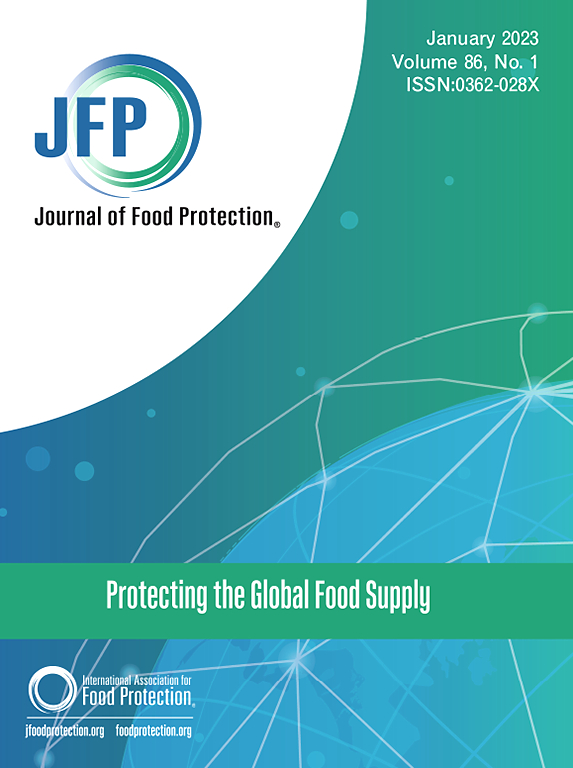Evaluation of a Postbiotic on Salmonella enterica Prevalence, Serotype Diversity, and Antimicrobial Resistance in the Subiliac Lymph Nodes of Cull Dairy Cattle
IF 2.1
4区 农林科学
Q3 BIOTECHNOLOGY & APPLIED MICROBIOLOGY
引用次数: 0
Abstract
This study aimed to determine whether the farm-level use of a Saccharomyces cerevisiae-based postbiotic was associated with Salmonella prevalence and concentration, serotype diversity, and antimicrobial resistance in the subiliac lymph nodes (LN) of cull dairy cows. In collaboration with two commercial processing plants in the Southwestern (SW) and Northeastern (NE) regions of the U.S., cull dairy cattle lots processed in the same week from dairy farms that fed or not the postbiotic were sampled. Up to 20 LN were collected from dairy cattle from each supplier farm at least once every season. Samples were analyzed for Salmonella by culture and quantitative PCR methods, and isolates were subjected to serotype identification and antimicrobial susceptibility testing. Although a numerically lower prevalence was observed, the preharvest administration of the postbiotic was not significantly associated with Salmonella prevalence in cull dairy cattle. However, Salmonella prevalence significantly varied by region; the SW region showed a higher prevalence than the NE region. Whereas dominant Salmonella serotypes included Montevideo, Mbandaka, Muenster, Cerro, Meleagridis, and Anatum, the probability of isolating a dominant serotype did not significantly vary by feed additive status (FAS) or region, but varied by season. Up to 34 isolates (out of 391) exhibited resistance to each antimicrobial, with the highest number of isolates exhibiting resistance to streptomycin and ciprofloxacin; however, this did not significantly vary by FAS, season, or region. The precise reasons for the lack of effectiveness of the postbiotic in reducing Salmonella burden are unknown; however, varied administration durations of the postbiotic due to culling at different lactation cycle stages or during dry periods may have hindered its impact, especially if dairy cows were culled early. Other factors may include dietary components, farm management practices, and external environmental influences.
评估后益生菌对宰杀奶牛髂下淋巴结中肠炎沙门氏菌流行率、血清型多样性和抗菌药耐药性的影响。
本研究旨在确定牧场使用基于酿酒酵母的益生菌是否与奶牛髂下淋巴结(LN)中沙门氏菌的流行率和浓度、血清型多样性以及抗菌药耐药性有关。我们与美国西南(SW)和东北(NE)地区的两家商业加工厂合作,对奶牛场在同一周内加工的奶牛批次进行了采样,这些批次的奶牛饲喂或未饲喂后生素。每个供应农场每季至少从奶牛身上采集一次,每次采集多达 20 头 LN。通过培养和定量 PCR 方法对样本进行沙门氏菌分析,并对分离物进行血清型鉴定和抗菌药敏感性测试。尽管从数量上观察到的沙门氏菌感染率较低,但收获前使用益生菌后与宰杀奶牛中的沙门氏菌感染率并无明显关联。不过,不同地区的沙门氏菌感染率存在显著差异;西南地区的感染率高于东北地区。虽然沙门氏菌的主要血清型包括蒙得维的亚、姆班达卡、明斯特、塞罗、梅莱格里迪斯和阿纳图,但分离出主要血清型的概率并不因饲料添加剂状态(FAS)或地区而显著不同,而是因季节而异。多达 34 个分离物(共 391 个)对每种抗菌素都表现出抗药性,其中对链霉素和环丙沙星表现出抗药性的分离物数量最多,但这并不因饲料添加剂状况、季节或地区的不同而有显著差异。然而,由于在不同的泌乳周期阶段或在干燥时期宰杀奶牛而导致的后效杀菌剂用药时间不同,可能会影响其效果,尤其是在奶牛被提前宰杀的情况下。其他因素可能包括日粮成分、牧场管理方法和外部环境的影响。
本文章由计算机程序翻译,如有差异,请以英文原文为准。
求助全文
约1分钟内获得全文
求助全文
来源期刊

Journal of food protection
工程技术-生物工程与应用微生物
CiteScore
4.20
自引率
5.00%
发文量
296
审稿时长
2.5 months
期刊介绍:
The Journal of Food Protection® (JFP) is an international, monthly scientific journal in the English language published by the International Association for Food Protection (IAFP). JFP publishes research and review articles on all aspects of food protection and safety. Major emphases of JFP are placed on studies dealing with:
Tracking, detecting (including traditional, molecular, and real-time), inactivating, and controlling food-related hazards, including microorganisms (including antibiotic resistance), microbial (mycotoxins, seafood toxins) and non-microbial toxins (heavy metals, pesticides, veterinary drug residues, migrants from food packaging, and processing contaminants), allergens and pests (insects, rodents) in human food, pet food and animal feed throughout the food chain;
Microbiological food quality and traditional/novel methods to assay microbiological food quality;
Prevention of food-related hazards and food spoilage through food preservatives and thermal/non-thermal processes, including process validation;
Food fermentations and food-related probiotics;
Safe food handling practices during pre-harvest, harvest, post-harvest, distribution and consumption, including food safety education for retailers, foodservice, and consumers;
Risk assessments for food-related hazards;
Economic impact of food-related hazards, foodborne illness, food loss, food spoilage, and adulterated foods;
Food fraud, food authentication, food defense, and foodborne disease outbreak investigations.
 求助内容:
求助内容: 应助结果提醒方式:
应助结果提醒方式:


